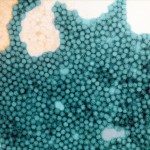Lien vers Pubmed [PMID] – 25096874
MBio 2014;5(4):e01119-14
Most of the circulating vaccine-derived polioviruses (cVDPVs) implicated in poliomyelitis outbreaks in Madagascar have been shown to be recombinants between the type 2 poliovirus (PV) strain of the oral polio vaccine (Sabin 2) and another species C human enterovirus (HEV-C), such as type 17 coxsackie A virus (CA17) in particular. We studied intertypic genetic exchanges between PV and non-PV HEV-C by developing a recombination model, making it possible to rescue defective type 2 PV RNA genomes with a short deletion at the 3′ end by the cotransfection of cells with defective or infectious CA17 RNAs. We isolated over 200 different PV/CA17 recombinants, using murine cells expressing the human PV receptor (PVR) and selecting viruses with PV capsids. We found some homologous (H) recombinants and, mostly, nonhomologous (NH) recombinants presenting duplications of parental sequences preferentially located in the regions encoding proteins 2A, 2B, and 3A. Short duplications appeared to be stable, whereas longer duplications were excised during passaging in cultured cells or after multiplication in PVR-transgenic mice, generating H recombinants with diverse sites of recombination. This suggests that NH recombination events may be a transient, intermediate step in the generation and selection of the fittest H recombinants. In addition to the classical copy-choice mechanism of recombination thought to generate mostly H recombinants, there may also be a modular mechanism of recombination, involving NH recombinant precursors, shaping the genomes of recombinant enteroviruses and other picornaviruses. Importance: The multiplication of circulating vaccine-derived polioviruses (cVDPVs) in poorly immunized human populations can render these viruses pathogenic, causing poliomyelitis outbreaks. Most cVDPVs are intertypic recombinants between a poliovirus (PV) strain and another human enterovirus, such as type 17 coxsackie A viruses (CA17). For further studies of the genetic exchanges between PV and CA17, we have developed a model of recombination, making it possible to rescue defective PV RNA genomes with a short deletion by cotransfecting cells with the defective PV genome and CA17 genomic RNA. Numerous recombinants were found, including homologous PV/CA17 recombinants, but mostly nonhomologous recombinants presenting duplications of parental sequences preferentially located in particular regions. Long duplications were excised by passages in cultured cells or in mice, generating diverse homologous recombinants. Recombination leading to nonhomologous recombinants, which evolve into homologous recombinants, may therefore be seen as a model of genetic plasticity in enteroviruses and, possibly, in other RNA viruses.


